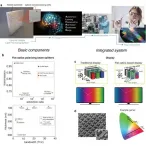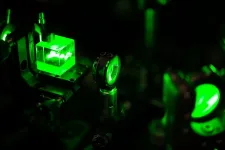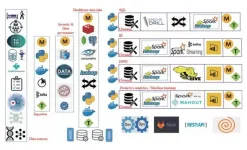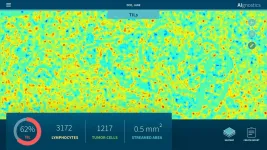Innovative flat optics will usher the next technological revolution and will touch all of us
2021-03-09
(Press-News.org) In a new paper published in Light Science & Application, the group led by Professor Andrea Fratalocchi from Primalight Laboratory of the Computer, Electrical and Mathematical Sciences and Engineering (CEMSE) Division, King Abdullah University of Science and Technology (KAUST), Saudi Arabia, introduced a new patented, scalable flat-optics technology manufactured with inexpensive semiconductors.
The KAUST-designed technology leverages on a previously unrecognized aspect of optical nanoresonators, which are demonstrated to possess a physical layer that is completely equivalent to a feed-forward deep neural network.
"What we have achieved," explains Fratalocchi, "is a technological process to cover flat surfaces, which in optical jargon are called flat optics, with "physical" neural units that are able to process light as a neural network does with an electrical signal"
These innovative flat optics achieve near unity efficiencies (up to 99%) in the visible range in ultrathin surfaces, which provides broadband and vectorial light control in both transmission and reflection with the desired wavefront shape. Moreover, the silicon nanoshape surface is ultrathin (60 nanometers thick, 1 nm=1/1000000 of 1mm) and can be customized on flexible surfaces.
The program used to design the nanosurface runs on KAUST's Shaheen-II supercomputer, a Cray XC40 delivering over 7.2 Pflop/s of theoretical peak performance, and is carried out with the Autonomous Learning Framework for Rule-based Evolutionary Design software developed by Fratalocchi and his team.
"We have developed a program that uses artificial intelligence to design the nanoresonators. The algorithm works using evolutionary techniques: in simple terms, the algorithm is able to train itself and improves its results after every cycle to produce surfaces of increasing efficiency every time that it is run. In our article, we showed experimental components with better performance than the current state of the art in flat-optics or from commercial devices available from leading companies, such as Thorlabs and Newport."
The KAUST research team is currently planning to use flat optics to develop new flat devices that could revolutionize older technologies based on bulk optics. Among the innovations, Fratalocchi and his team are building a human-eye camera, a bio-sensor able to "read" cells infected with malaria and new types of displays.
"There are really endless applications," explains Fratalocchi, "because almost all existing measurement systems, in principle, could be substituted by their cost-effective, compact flat-optics versions. We are developing a statistical learning approach that, for any given measurement task, designs a correspondent flat-surface that "encodes" the measure into a single optical image, or logogram. With this approach, the entire field of sensing and metrology could become natural language processing based on nonlinear logograms."
"One of our current projects is a flat camera that can see even better than the human eye, which is limited by using only three primary receptors for color vision. We can also miniaturize any component, no matter how bulky," adds Fratalocchi. "The key concept here is that a neural network is a universal approximator that can learn any function. For this reason, we can train our flat optics to perform any task, or a sequence of tasks currently performed by electronic systems, just in less space and at the speed of light."
"With proper funding and resources," concludes Fratalocchi, "in five to 10 year's time, most of today's bulky technology will have shrunk to pocket size, with a similar revolution that electronics experienced at the end of the last century."
INFORMATION:
[Attachments] See images for this press release:

ELSE PRESS RELEASES FROM THIS DATE:
2021-03-09
Obtaining a precise understanding of magnetic structures is one of the main objectives of solid-state physics. Significant research is currently being undertaken in this field, the aim being to develop future data processing applications that use tiny magnetic structures as information carriers. Physicists at Johannes Gutenberg University Mainz (JGU) and the Helmholtz Institute Mainz (HIM) recently presented a new method for investigating magnetic structures combining two different techniques. This allows to measure and map the magnetization as well as the magnetic ...
2021-03-09
For ice, so-called "surface melting" was postulated as early as the 19th century by Michael Faraday: Already below the actual melting point, i.e. 0 °C, a thin liquid film forms on the free surface because oft he interface between ice and air. Scientists led by Markus Mezger, group leader at the Max Planck Institute for Polymer Research (department of Hans-Jürgen Butt) and professor at the University of Vienna, have now studied this phenomenon in more detail at interfaces between ice and clay minerals.
In nature, this effect is particularly interesting in permafrost soils - i.e. soils that are permanently frozen. About a quarter of the land area ...
2021-03-09
The efficient provision of medical care is integral to society. Over time, the healthcare industry has tapped into modern technology in order to keep up its quality of service. This has, unsurprisingly, led to huge volumes of patient data. But it's not just patients whose data need to be stored; doctors, physicians, clinical staff, and even smart wearable gadgets are contributing to what is coming to be known as "healthcare big data."
Big data analytics (BDA), which involves the use of special design architectures to manage, store, and analyze complex data, is an important tool in healthcare. But it is hard to implement, owing to its high failure rate, resource-intensive process, and--most importantly--a lack of a clear guideline to aid practitioners. ...
2021-03-09
Light microscopes have revolutionized our understanding of the microcosmos, but their resolution is limited to about 100 nanometers. To see how molecules bond, break, or change their structure, we need at least 1000 times better resolution.
Laser induced electron diffraction (LIED) is a technique which allows to pinpoint the individual atoms inside a single molecule, and to see where each atom moves when the molecule undergoes a reaction. This technique proved to be an amazing tool for the imaging molecules, such as water, carbonyl sulfide or carbon disulfide. However, using a strong laser field to generate the electron diffraction presented challenges in retrieving the exact structure, since the structural resolution depended on exact knowledge of the ...
2021-03-09
New Haven, Conn. -- Mailing a package of SARS-CoV-2 tests to every household in America and asking people to use them once a week could greatly reduce total infections and mortality at a justifiable cost, a new study led by the Yale School of Public Health finds.
The research, published today in Annals of Internal Medicine, considers rapid antigen tests that warn people, in real-time, that they are potentially contagious and that they should isolate themselves before unknowingly spreading the disease to others. Investigators, led by Professor A. David Paltiel, assembled data on the epidemiology of SARS-CoV-2 and the natural history of COVID-19. They then used a mathematical model to estimate how many infections, hospitalizations, and deaths could be averted - and at what cost - by providing ...
2021-03-09
As much as a year's worth of past academic progress made by disadvantaged children in the Global South may have been wiped out by school closures during the COVID-19 pandemic, researchers have calculated.
The research, by academics from the University of Cambridge and RTI International, attempts to quantify the scale of learning loss that children from poor and marginalised communities in the Global South may have experienced, and the extent to which home support and access to learning resources could ameliorate it. While it is known that the education of these children has suffered disproportionately during the pandemic, it is much harder to measure exactly how much their academic progress has ...
2021-03-09
Women with polycystic ovary syndrome (PCOS) are at a significantly increased risk of contracting COVID-19 than women without the condition, new research led by the University of Birmingham has revealed.
Researchers are now calling for healthcare policy to specifically encourage women with PCOS to adhere to COVID-19 infection control measures while the global pandemic continues.
Polycystic ovary syndrome (PCOS) is a common condition affecting around one in 10 women in the UK. The three main symptoms are irregular periods, high levels of "male" hormones which may cause physical signs such as excess facial or body hair, and a cystic appearance on an ultrasound or MRI scan of the ovaries which is caused by follicles becoming increasingly fluid filled as they fail to develop and ...
2021-03-09
Researchers at Charité - Universitätsmedizin Berlin and TU Berlin as well as the University of Oslo have developed a new tissue-section analysis system for diagnosing breast cancer based on artificial intelligence (AI). Two further developments make this system unique: For the first time, morphological, molecular and histological data are integrated in a single analysis. Secondly, the system provides a clarification of the AI decision process in the form of heatmaps. Pixel by pixel, these heatmaps show which visual information influenced the AI decision process and to what extent, thus enabling doctors to understand and assess the plausibility of the results of the AI analysis. This represents ...
2021-03-09
People with unhealthy heart structures and poorer functioning hearts have a significantly higher risk of being diagnosed with COVID-19 infection, according to research by Queen Mary University of London, in collaboration with the Medical Research Council Lifecourse Epidemiology Unit (The University of Southampton).
The researchers made use of the comprehensive and internationally unique UK Biobank database, which includes health and genetic information from over half a million participants from across the UK, including detailed magnetic resonance imaging (MRI) of their hearts as well as linkages to COVID-19 test results from Public Health England.
The team investigated records from 310 Biobank participants to see whether pre-existing features of the heart ...
2021-03-09
In light of the United Nations (UN) declaration that 2021-2030 is the UN Decade on Ecosystem Restoration, a group of scientists voice concerns about restoration in heavily fragmented landscapes under a hotter and drier future scenario.
Poor recovery of small fragments will end up costing management and wider society later down the line. Millions are invested in setting aside patches, but management is then weak and costly.
Rainforests turn into oil palm plantations
The past 40 years in Southeast Asia have seen about 50% of lowland rainforests converted to oil palm and other plantations, and much of the remaining forest heavily logged.
Little is known about how fragmentation influences recovery and whether climate change will hamper restoration.
"Here, we use repeat airborne ...
LAST 30 PRESS RELEASES:
[Press-News.org] Innovative flat optics will usher the next technological revolution and will touch all of us





